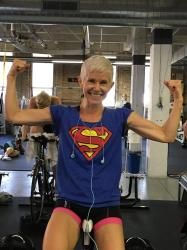With the exception of a few athletes, most people have now pretty much wound down their competitive seasons. Some are taking some much needed rest, while others are already actively pursuing their goals for 2009. In either case, most of the work that we are doing right now is relatively unstructured when compared to the regimented training we engaged in to get us ready for our biggest goals during the past season. That’s certainly been true of the indoor ride schedule as of late. They certainly haven’t been easy workouts, but we’re not yet focusing on improving any one system or ability. Instead, we’re giving athletes a little of everything to hit all the systems a little bit every 2-3 weeks and maintain the fitness and power earned over the past year.
As we start to transition from the very general training of the “off-season” to the somewhat more specific training of the “pre-season” one of the most important things you can do for yourself and your training is get some good reference points for exactly where you’re at in as many areas as possible: aerobic, threshold, anaerobic and explosive power, run & swim fitness, flexibility, strength, stability, bike handling, pedaling skills, stroke economy and running form. Objectively measuring these and other factors can help athletes to determine what their rate limiting factors are and make more effective use of off-season and pre-season training to improve weaknesses.
The other advantage of obtaining current benchmarks is that you will be able to more accurately apply the appropriate training dose. If you were burned out at the end of the season and took an extended lay-off, you may have lost a little bit of the power you once had. Trying to come back at the same level could potentially set you up for a bad training cycle and compromise your ability to work out and recover during what should be a fairly low key time of the year. Others who are relatively new to endurance sports may still be seeing rapid gains in fitness and benchmarking is worthwhile for these individuals as well so that they are training at appropriate levels to continue growing.
Essentially, benchmarking is testing, and the word “test” tends to cause people to shy away. As Robbie mentioned above, there are several reason why we are often afraid to test ourselves, either because we don’t want to suffer that much, because we’re afraid we may not do as well as in the past, or because we’re afraid of what others might think. But there are a few important things to note:
- Not all tests have to be hard work. To assess efficiency on the swim, bike or run, all you need to do is have a qualified coach or instructor observe you working out. Bike handling skills may be challenging, but not physically strenuous.
- You won’t always improve on every test. Most often improvements come in chunks and a multitude of factors determine how frequent those jumps come. The specific training you have been doing also means you may see big gains in one area, but little or no improvement in others.
- What others think shouldn’t matter. For most, endurance sports are about the individual achievement. Sometimes that means beating others, but ultimately what is required is consistent personal improvement. Benchmark testing will help to determine the areas that need the greatest amount of work will help to support that improvement.
Hopefully you have already taken the time to reassess your past season and started thinking ahead to 2009 goals. Now that you have had some time to recover and refocus your motivation, it is the perfect time to take the next step. Use benchmark testing to “restart” your training and get it started on the right foot.

